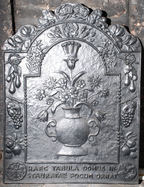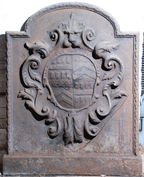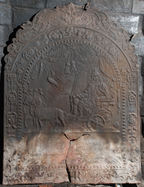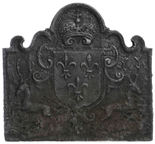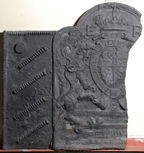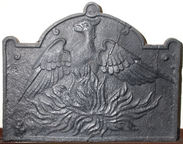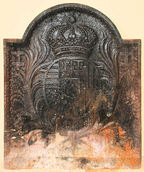-
813
Description: Arched rectangular central panel with bead and fillet edging; two-handled vase with flowers issuing from it, a triple plume of ostrich feathers above, and in the bottom right corner the inscribed inscription, 'CofA' [Charteris of Amisfield]; arched rectangular border with fillet edging; central rose at top of arch with other flowers to each side; successive bunches of pears, grapes and apples descending down each side; inscription (Haec tabula domus instauratae focum ornat) in relief in two rows along the bottom, with circular badges of the National Heritage Memorial Fund to left, and National Trust to right; on top, rope knotted in two loops, each containing half of the date in relief, with descending leaves and flowers on each side.
Notes: This fireback was cast for Martin, Lord Charteris of Amisfield (1913-99), Trustee of the National Heritage Memorial Fund, from a pattern he designed and made, to commemorate the completion of restoration work to Canons Ashby.
Inscription: 1984 / CofA / HAEC TABULA DOMUS IN- / STAURATAE FOCUM ORNAT [this plate adorns the hearth of a restored house]
Manufactured: in 1984 in England.
Current location: Canons Ashby, Canons Ashby, Northamptonshire, England.
Museum number: 494619 (part of the National Trust museum group)
- Attached to series:
- British 'Dutch' style firebacks
- Commemorative firebacks
- Martin Charteris firebacks
-
874
Description: Arched rectangular central panel with ovolo linking curves and eyelet astragal edging; pictorial scene of Delilah, seated above a pavement, supervising the cutting of Samson's hair by a barber, a putto to the left and a small figure lower right; drapery above; arched rectangular border with ovolo linking curves and fillet edging; symmetrical pattern of plant tendrils with leaves and seed pods; at bottom, monogram 'EB' in a cartouche between symmetrical leaves and ears of wheat; on top, two mirrored sea serpents.
Notes: One of a small series of firebacks identified by the EB monogram; the pictorial scene is of Delilah and the sleeping Samson with a Philistine cutting his hair; the scene may be based on an engraving by the Dutch artist Philip Galle (1537-1612) after a painting by Maerten van Heemskerck.
Copies of this fireback are known.
Inscription: EB
Manufactured: in the late 17th to early 18th century in England.
Current location: Chastleton House, Chastleton, Oxfordshire, England.
Museum number: 1430205 (part of the National Trust museum group)
- Attached to series:
- EB series
- Old Testament & Apocrypha firebacks
- British 'Dutch' style firebacks
-
34
Description: Arched rectangular shape; astragal and fillet edging (top and sides) with overlapping leaf pattern; floral cartouche with lion’s face at top, enclosing a shield bearing the arms of May (Gules, a fess between eight billets Or) quartering Broadnax (Or, two chevrons gules, on a chief of the last three cinquefoils Argent); at base a plain cuboid plinth.
Notes: Thomas Broadnax (1701-81), son of William Broadnax of Godmersham, Kent, and Anne May, heiress of Christopher May, inherited the estate of his cousin, Sir Thomas May, adopting his surname in 1727. He later changed his name to Knight on inheriting the estate of that family at Chawton in 1738.
Arms: May quartering Broadnax
- Decoration tags:
- arched rectangular (shape)
- astragal & fillet (edging)
- carved pattern panels
- armorial
Manufactured: in the early 18th century possibly in the Weald area of England.
Current location: Chawton House, Chawton, Hampshire, England.
- Attached to series:
- Personal armorial firebacks
-
257
Description: Arched rectangular central panel with ‘nutshell’ edging on a broad fillet; crowned figure, holding a sceptre in his right hand, sitting in a chariot drawn to the left by two horses with ostrich feather head-dresses; the whole upon a causeway with pilasters and masonry, and waves beneath; a heron flying to the left; above, swagged drapery with two tassels hanging from the centre; arched rectangular shaped border with fillet edging, symmetrical, flower bunches, descending from a ribbon loop; monogram centre bottom, between plant tendrils; on top, symmetrical scrolled plant tendrils.
Notes: The design is derived from a personification of Europe, one of a set of playing cards entitled 'Jeu de la Géographie', designed by Stefano della Bella (1677); a similarity with Queen Anne may not be coincidental; the flying heron has been copied from a print by Wenceslaus Hollar c.1658.
Copies of this fireback are known.
Inscription: SHR
Manufactured: in the late 17th to early 18th century in England.
Current location: Chiddingstone Castle, Chiddingstone, Kent, England.
- Attached to series:
- SHR series
- British 'Dutch' style firebacks
-
824
Description: Rectangular with complex quasi-arched rectangular top; ovolo moulded edging; shield with Royal arms of France in a swirled cartouche; above, an English crown; below to right and left, a prancing stag.
Notes: The combination of the English crown and French arms is common and may relate to the marriage of Charles I and Princess Henrietta Maria of France in 1625; although the framing of the pattern is very similar to others of the same basic design, the style suggests a different pattern maker. Christie's auction 21 Jun 2011 lot 208 (£2,750).
Copies of this fireback are known.
Arms: France modern
- Decoration tags:
- complex quasi-arched rectangular (shape)
- ovolo (edging)
- whole carved pattern
- armorial
- animals
Manufactured: in the early to mid 17th century possibly in the Weald area of England.
Current location:, not known.
- Attached to series:
- Ornate border series
- Miscellaneous royal firebacks
- Anglo-French armorial firebacks
-
403
Description: Fragment; arched rectangular shape with rounded corners; ovolo within fillet moulding all round; oval Tudor royal shield with garter surrounding, topped with a royal crown; dragon and (missing)greyhound supporters; initials split by crown; inscription on a fillet between legs of supporters, behind garter finial; motto on an Ionic plinth at bottom; rectangular side panels with twisted rope edging top and side; a short length of turned dowel stamped four times, diagonally, on each panel; a circular disc with concentric grooves in top left corner.
Notes: Similar to a fireback in the Victoria & Albert Museum, but differentiated by the twisted rope edging of the side panel and the addition of the grooved disc. The disparity between the worn surface of the armorial panel and the greater clarity of the extensions indicates that the extended casting was made using an already well-used armorial fireback and therefore at a substantially later date.
Inscription: E R / HONY SOIT QUE ... / Made in Sussex by J... / DV ET MOV...
Arms: Tudor royal - Edward VI
- Decoration tags:
- extended quasi-arched rectangular (shape)
- rope (edging)
- simple stamps
- carved stamps
- whole carved pattern
- extension panels
- armorial
- royal
- text
- objects
Manufactured: in the late 16th century in the Weald area of England.
Current location: Anne of Cleves House, Southover High Street, Lewes, East Sussex, England.
Museum number: LH000.916 (part of the Sussex Archaeological Society museum group)
- Attached to series:
- Pounsley series
- John Harvo series
- Tudor royal armorial firebacks
-
409
Description: Quasi-arched rectangular shape, semi-circular protrusions on top corners; circular loop at top of arch; fillet edging with small twists inside arch, and curls inside and below top corners; a phoenix in flames, its wings displayed and inverted.
Notes: The use of the loop in the edging draws comparisons with other firebacks, and may indicate the same source. Formerly part of the J. H. Every collection.
- Decoration tags:
- quasi-arched rectangular (shape)
- fillet (edging)
- whole carved pattern
- planklines
- pictorial
- mythological
- animals
Manufactured: in the mid to late 17th century possibly in the Weald area of England.
Current location: Anne of Cleves House, Southover High Street, Lewes, e, England.
Museum number: 1944.24.061 (part of the Sussex Archaeological Society museum group)
- Attached to series:
- Loop edged firebacks
- Phoenix firebacks
-
606
Description: Canted rectangle; twisted rope edging (top and sides); seven shields of Ayloffe impaling Sulyard in two rows (3-4); Ayloffe: sable, a lion rampant Or, collared gules, between three crosses formy of the second; Sulyard: argent, a chevron gules between three pheons inverted sable.
Notes: William Ayloffe (c1535-1584) of Hornchurch, Essex, Justice of the Court of Queen’s Bench, married (c1560) Jane, dau. of Sir Eustace Sulyard, of Runwell, Essex.
Arms: Ayloffe impaling Sulyard (William Ayloffe of Bretons, Hornchurch)
- Decoration tags:
- canted rectangular (shape)
- rope (edging)
- carved stamps
- armorial
Manufactured: in the early 17th century in the Weald area of England.
Current location: Mark Ripley Forge & Fireplaces, Northbridge Street, Robertsbridge, East Sussex, England.
- Attached to series:
- Ayloffe series
- Personal armorial firebacks
-
820
Description: Arched rectangular shape; wide fillet and egg-and-dart ovolo edging; central oval armorial with fillet edging, palm fronds on each side, tied below, a crown above; in each top corner, the cross of Lorraine.
Notes: The arms are those of Duke Leopold I of Lorraine, who also bore the titles of King of Jerusalem, Hungary and Aragon, and Duke of Anjou, Bar, Gueldre and Juliers.
Arms: Leopold I, Duke of Lorraine and Bar (1680-1729)
- Decoration tags:
- arched rectangular (shape)
- ovolo, egg and dart (edging)
- whole carved pattern
- armorial
Manufactured: in the early 18th century possibly in the Lorraine area of France.
Current location:, not known.
- Attached to series:
- Foreign armorial firebacks
